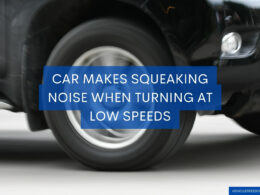In This Article Show
An unwelcome crackling sound from your car dashboard can disrupt a peaceful driving experience. Though it’s natural to be concerned, knowing the possible can put your mind at ease.
The cracking sound originating from a car dashboard may be due to multiple reasons. It may be a faulty blend door actuator, a bad relay, an uncalibrated HVAC, a malfunctioning stepper motor, or even AC leaks.
However, you don’t have to worry since we have compiled a comprehensive guide to help you diagnose and fix this issue.
Crackling Sound in Car Dashboard [5 Possible Causes]
Noises from your car, whether external or originating within the dashboard, often indicate something is amiss. Recognizing these auditory warning signs is essential for accurately diagnosing and addressing the underlying issues.
Here’s a list of 5 possible causes (with their potential fixes) of why you might hear a crackling sound from the car’s dashboard:
1. Bad Blend Door Actuator
The blend door actuator is a small motor that controls the movement of the blend door in your car’s HVAC system. This door/vent regulates the mix of hot and cold air coming from the heater core and the evaporator. This is the actual motor that allows you to adjust the temperature inside your car.
When this actuator turns bad,it can create a thumping sound as it struggles to move the blend door.
To properly diagnose this issue, listen to the noise around the control panel when changing the temperature settings in your car. If the sound is consistent with the temperature change, the blend door actuator is probably at fault and needs replacement.
How to replace a blend door actuator?
- With your safety gloves on, disconnect the battery terminals.
- Locate the blend actuator based on your vehicle’s manual. It is typically under the dashboard glove box, near the passenger side.
- Take out the glove box to expose the actuator.
- Disconnects all of its mountings (screws) and electrical connections. (Consult your vehicle’s service manual for specific instructions on accessing and replacing the actuator.)
- Check out its specifications and replace it with a new one that matches them.
2. Uncalibrated HVAC
Your car’s heater or, technical speaking, HVAC (Heating, Ventilation, and Air Conditioning) system controls the climate inside your vehicle. It maintains a comfortable temperature by regulating the flow of hot and cold air through the vents.
An uncalibrated HVAC system can cause a crackling sound due to improper airflow regulation.
To diagnose if the HVAC is the culprit, check if the sound emerges when the HVAC system is running. If it does, calibration might be necessary.
How to calibrate the HVAC system?
To recalibrate your HVAC system, follow these steps:
- Start the car, and press the AC’s auto button after a while.
- Keep it running for 4-5 minutes, then turn the car off.
- Locate the AC fuse within the box, and take it out.
- Insert it back after a couple of minutes and restart the vehicle.
3. Leaks Within AC Vents
The AC vents distribute cooled air from the air conditioning system throughout your car’s cabin. They are designed to direct airflow effectively and quietly.
Leaks within the AC vents can produce a hissing sound as air escapes through unintended openings. Moreover, any leakage within ducts may produce the same noise.
If the crackling noise is present when the AC is running, it could be due to a leak in the vent system. However, to be sure need to get the AC system checked by a professional.
How to fix it?
Depending on the extent of the damage, fixing a leaky vent may involve sealing the cracks with an appropriate sealant or replacing the damaged vent entirely. However, for you, it may be hard to trace those leaks. Therefore, you must get it inspected by an HVAC technician.

4. Damaged Relay
Relays are electrical switches that control various components in your car, such as the starter motor, fuel pump, and cooling fan. They allow for the safe operation of these components by isolating them from high current flows.
However, a faulty relay can be the source of crackling sound as it fails to make proper electrical connections.
To diagnose this issue, identify the component associated with the noise and locate its relay. Touch it and you may feel it clicking sound. Also, shaking it will make a rattle, indicating it’s damaged inside.
How to Fix a Bad Relay?
- Locate the relay in your car’s fuse box or relay panel. Refer to the wiring diagrams in the car’s manual.
- Pull out the old relay.
- Replace it with a new one and make sure all the pins sit perfectly in their places.
5. Faulty Stepper Motor
A stepper motor moves in discrete steps, allowing for accurate positioning and control.In automotive applications, stepper motors are commonly used in various systems, such as instrument panel gauges, climate control systems, and electronic throttle control.
When one of the stepper motors associated with instrument panels has worn-out internal components, it may produce some noise. Old cars had magnetic pins for movement assistance which may produce some ticking or clicking sound.
How to Fix?
If you suspect a faulty stepper motor, the most effective solution is to replace it.
This process involves disconnecting the battery, accessing the stepper motor by removing the necessary panels or covers, disconnecting the electrical connections, and then installing the new stepper motor.
However, this won’t be an easy job for most car owners. So, we advise you to take to a professional car electrician for correct diagnosis and repairs.
Final Thoughts
Various issues, such as a bad blend door actuator, an uncalibrated HVAC system, or leaks within the AC vents can cause a crackling sound in your car dashboard.
By understanding the function of each component and following the diagnosis and fixing methodologies outlined in this article, you can address the issue and restore peace to your driving experience.
However, if you don’t feel confident doing these repairs yourself, consult a mechanic with some professional expertise.










